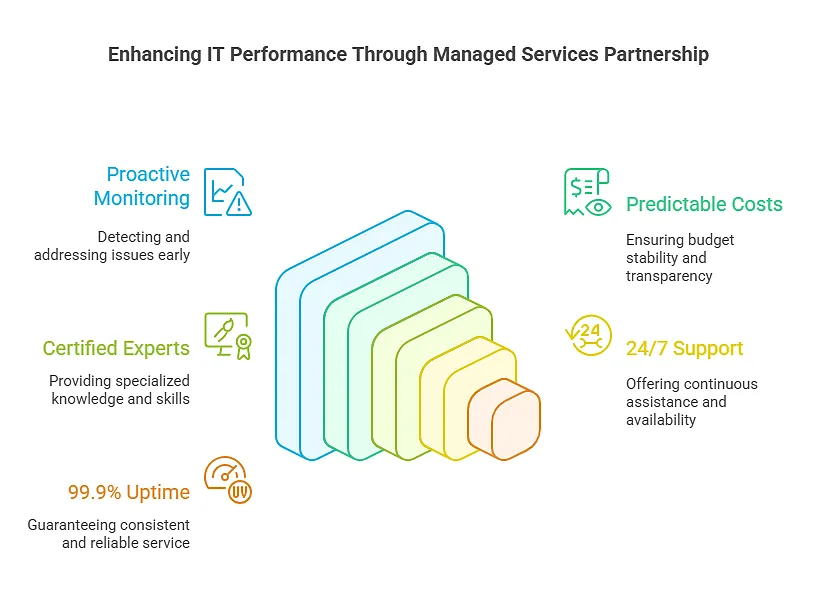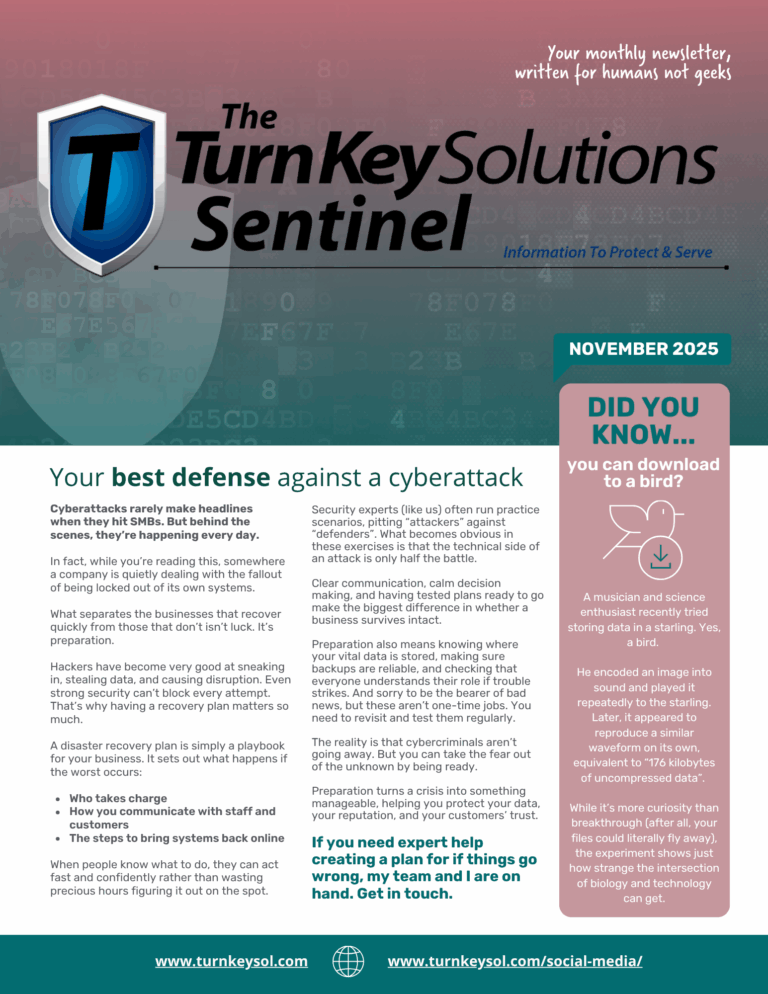

Every business has faced it: the sudden Wi-Fi failure during a client pitch, a frozen system on payroll day, or an email outage that paralyzes communication. These IT problems don’t arrive unannounced. They strike at the worst possible moments, and for small and mid-sized businesses (SMBs), the consequences go far beyond inconvenience.
The real cost of downtime is steep: lost productivity, missed revenue, reputational damage, and mounting frustration among teams who rely on seamless technology to do their jobs.
According to CloudSecureTech, small businesses lose an average of $137 per minute of downtime, depending on the industry. For SMBs, even a fraction of that can be a serious blow to operations and customer trust.
Henry D. Overton, President & Co-Founder at Turn Key Solutions, puts it best:
“Technology shouldn’t feel like a constant fire drill. The goal is to make IT invisible, reliable enough that you don’t have to think about it.”
The good news? These problems are preventable. This blog explores the most common IT pain points and how proactive, well-managed IT support can help you stay ahead of disruptions. From smarter monitoring to strategic outsourcing, we’ll show you how to keep your business moving, even when tech hiccups threaten to slow you down.
End IT Problems Before They End Your Workday!Stop reacting to tech failures. Start preventing them with 24/7 monitoring, expert support, and a 99% uptime guarantee. |
Why Businesses Keep Facing IT Problems
Despite investments in modern infrastructure and updated tools, IT problems continue to disrupt businesses. Why is this the case? Technology evolves faster than most organizations can adapt, and without a proactive strategy, even well-equipped teams fall behind.
These recurring issues often stem from a few predictable, and preventable, patterns:
1. Outdated Systems That No Longer Support Business Growth
A recent Paubox Report revealed that 83% of healthcare IT teams are still battling legacy systems that slow down their daily operations. Legacy hardware and software may still function, but they quietly erode performance. They introduce compatibility issues, slow down operations, and create vulnerabilities that are harder to patch.
Worse, they often lack the scalability required to support growing teams or expanding digital services. Upgrading to modern, cloud-ready systems ensures your technology accelerates growth instead of holding it back.
2. Reactive IT Management
Many small and mid-sized businesses still rely on a break-fix model, addressing IT issues only when they’ve already caused damage. This reactive approach leads to longer downtimes, higher emergency costs, and constant firefighting.
In contrast, proactive IT management, including real-time monitoring, automated alerts, and managed services, can detect and resolve issues before they impact operations.
3. Lack of Employee Awareness
Technology is only as strong as the people using it. Employee errors, such as weak passwords, accidental data deletion, or falling for phishing scams, remain one of the top causes of IT incidents.
In the absence of regular training and clear security protocols, even the best systems are vulnerable. Building a culture of IT awareness strengthens your company’s resilience and reduces preventable risks.
The Most Common Technology Problems Businesses Face
Technology touches every corner of a modern business, so even minor glitches can ripple across departments. These everyday issues often point to deeper infrastructure gaps that, if left unaddressed, can hinder performance and growth.
1. Slow Network and Connectivity Issues
Lagging internet speeds or frequent disconnects can cripple productivity and frustrate teams. These problems typically stem from poor network design, aging hardware, or bandwidth strain.
When connectivity falters, businesses often experience:
- Delayed communication and collaboration
- Disrupted video calls and cloud access
- Frustrated employees and clients
To keep operations running smoothly, consider these steps:
- Conduct a network performance audit to identify bottlenecks
- Upgrade to business-grade routers and switches with QoS features
- Partner with managed IT providers to monitor usage patterns and optimize performance in real time
2. System Downtime and Server Failures
Each year, 10 to 20 major IT outages make global headlines, each one costing millions in revenue. When servers go offline, operations grind to a halt. Whether caused by hardware failure, power outages, or lack of a recovery plan, these disruptions can be costly and damaging.
Downtime can lead to:
- Lost revenue and productivity
- Data corruption or loss
- Damaged customer trust
To ensure continuity and fast restoration, businesses should:
- Migrate critical workloads to cloud-based infrastructure with built-in redundancy
- Implement automated failover systems and uninterruptible power supplies
- Develop and regularly test disaster recovery protocols
3. Data Loss and Inadequate Backups
Accidental deletions or failed backups can erase months of valuable work. Without a reliable backup strategy, recovery becomes slow and uncertain.
Here’s what’s at stake when backups fail:
- Permanent loss of critical files
- Regulatory non-compliance
- Costly recovery efforts and downtime
To protect data and ensure quick recovery, organizations should:
- Use automated, cloud-based backup solutions with encryption and versioning
- Schedule regular backup verification and recovery drills
- Apply role-based access controls to minimize accidental deletions
| More articles you might like: |
4. Security Vulnerabilities
Unpatched software and weak credentials leave systems exposed to cyber threats. These vulnerabilities are often exploited by attackers looking for easy entry points.
Here’s how security gaps can impact your business:
- Data breaches and financial loss
- Legal liabilities and compliance violations
- Reputational damage
Consider these three approaches to eliminating security vulnerabilities:
- Enforce routine system updates and patch management
- Implement multi-factor authentication and strong password policies
- Deploy endpoint detection and response tools for real-time threat monitoring
5. Integration Problems Across Tools
When business systems, such as CRMs, ERPs, and communication platforms, don’t communicate well, data silos form and workflows break down.
Here are some ways poor software/process integration affects businesses:
- Reduced productivity and collaboration
- Inaccurate data and reporting errors
- Slower decision-making
To improve collaboration and data accuracy, organizations should:
- Assess their technology stack to identify integration gaps
- Use middleware or APIs to connect disparate systems
- Work with managed IT experts to design custom integrations that streamline operations
How IT Problems Affect Business Performance
The financial toll of IT problems is easy to quantify: lost sales, repair costs, and missed deadlines. However, the indirect costs often go unnoticed. Unreliable systems don’t just slow down operations; they chip away at employee morale, customer trust, and your ability to grow.
Here’s how persistent IT issues quietly undermine core areas of business performance:
| Impact Area | Result of Persistent IT Problems | Business Outcome |
| Productivity | Employees waste hours fixing tech issues | Delayed projects and lower output |
| Customer Experience | Service disruptions during client interactions | Reduced trust and satisfaction |
| Profitability | Unexpected repair and downtime costs | Shrinking margins |
| Security | Poor patching and monitoring | Higher exposure to cyber risks |
| Growth | Limited scalability and agility | Missed innovation opportunities |
A 2025 research by Asanti found that 72% of IT decision makers experienced tech-related downtime in the past year. That’s a business risk. In contrast, companies with managed IT support report a 45-65% increase in operational efficiency, proving that proactive strategies do more than prevent problems; they protect performance.
When IT works seamlessly, your team can focus on what matters most: serving customers, innovating faster, and growing with confidence.
Solving Problems with IT Before They Escalate
Fixing IT problems isn’t only about applying quick patches. It’s more about building a system that prevents issues from surfacing in the first place. The real transformation happens when businesses shift from reactive fixes to preventive, integrated approaches that strengthen performance and resilience.
1. Adopt a Managed IT Service Model
One of the most effective ways to stay ahead of disruptions is by partnering with a managed service provider (MSP). With consistent monitoring, maintenance, and support, MSPs catch common technology problems early before they affect operations. This means fewer surprises, better cost control, and stronger uptime.
For example, Turn Key Solutions guarantees 99.9% network uptime and 24/7 helpdesk availability, ensuring your team always has support when it matters most.
2. Prioritize Regular System Audits
Many IT issues hide in plain sight until they cause downtime. That’s why scheduled audits are essential. By assessing hardware, software, and security posture quarterly, businesses can uncover inefficiencies, outdated components, and vulnerabilities before they escalate into costly failures.
3. Strengthen Data Protection Practices
Data integrity is foundational. Businesses should implement multi-layered security, including encryption, multi-factor authentication, and automated backups. These measures ensure that even if one layer is breached, others stand guard. Treating data protection as a proactive discipline helps safeguard operations and customer trust.
4. Invest in Employee Training
89% of companies report stronger security defenses after rolling out employee awareness training. Even the best systems are vulnerable if users aren’t equipped to handle them. Continuous training empowers employees to recognize threats, maintain digital hygiene, and follow best practices. Tech-savvy teams make fewer mistakes, reducing the risk of breaches and downtime caused by human error.
5. Align IT Strategy with Business Goals
Technology should drive growth. When IT strategy is aligned with business priorities, every investment in systems, software, and support becomes a step toward innovation, scalability, and competitive advantage. This alignment ensures that IT is a catalyst for progress.
Why Partnering with the Right IT Provider Matters

A reliable IT provider prevents problems. The right partner brings structure, foresight, and measurable outcomes that internal teams often struggle to maintain on their own. The goal is not to outsource tasks but to upgrade performance.
At Turn Key Solutions, that means:
- Proactive monitoring that detects and resolves issues before they disrupt operations
- Predictable costs through transparent monthly pricing, eliminating budget surprises
- Certified experts delivering 24/7 support and compliance-driven solutions
- 99.9% uptime guarantee with same-day response for critical issues
Overcome Technology Issues in Business with Turn Key Solutions
IT problems are inevitable, but chaos isn’t. The difference lies in how you prepare and who you partner with. A managed approach that combines preventive care, expert oversight, and scalable systems keeps your business focused on what truly matters: growth, client satisfaction, and innovation.
Turn Key Solutions transforms recurring technology issues in business into consistent, measurable results. Our data centers in Las Vegas and Dallas are engineered for performance and reliability, featuring redundant power, cooling, and strict security protocols. That means 99% uptime and a 4.2-minute IT support response time.
| Trusted Managed IT Services Near You
|
Don’t wait for the next outage to realize what better IT support feels like. Reach out now to schedule a consultation with our experts.








